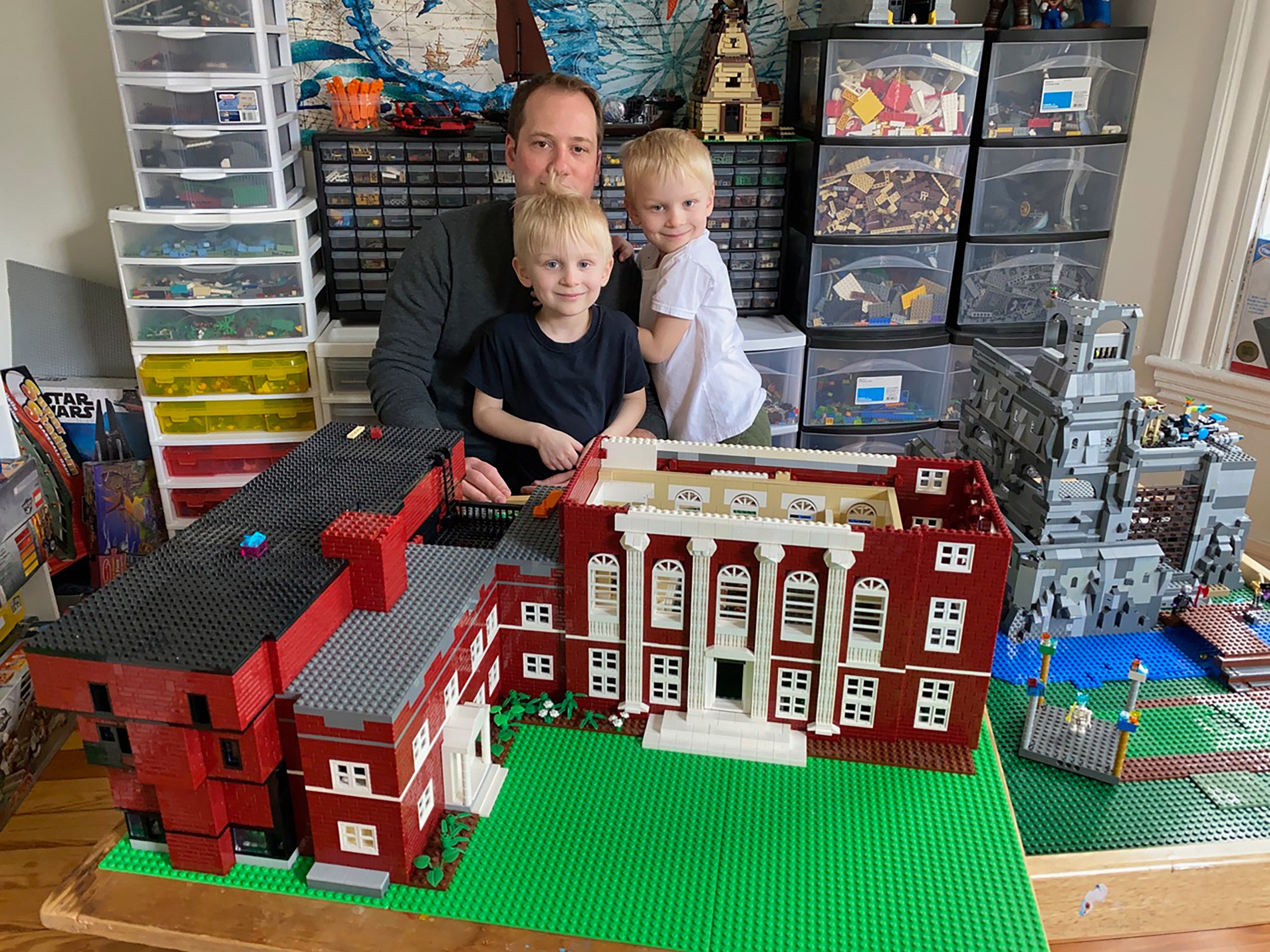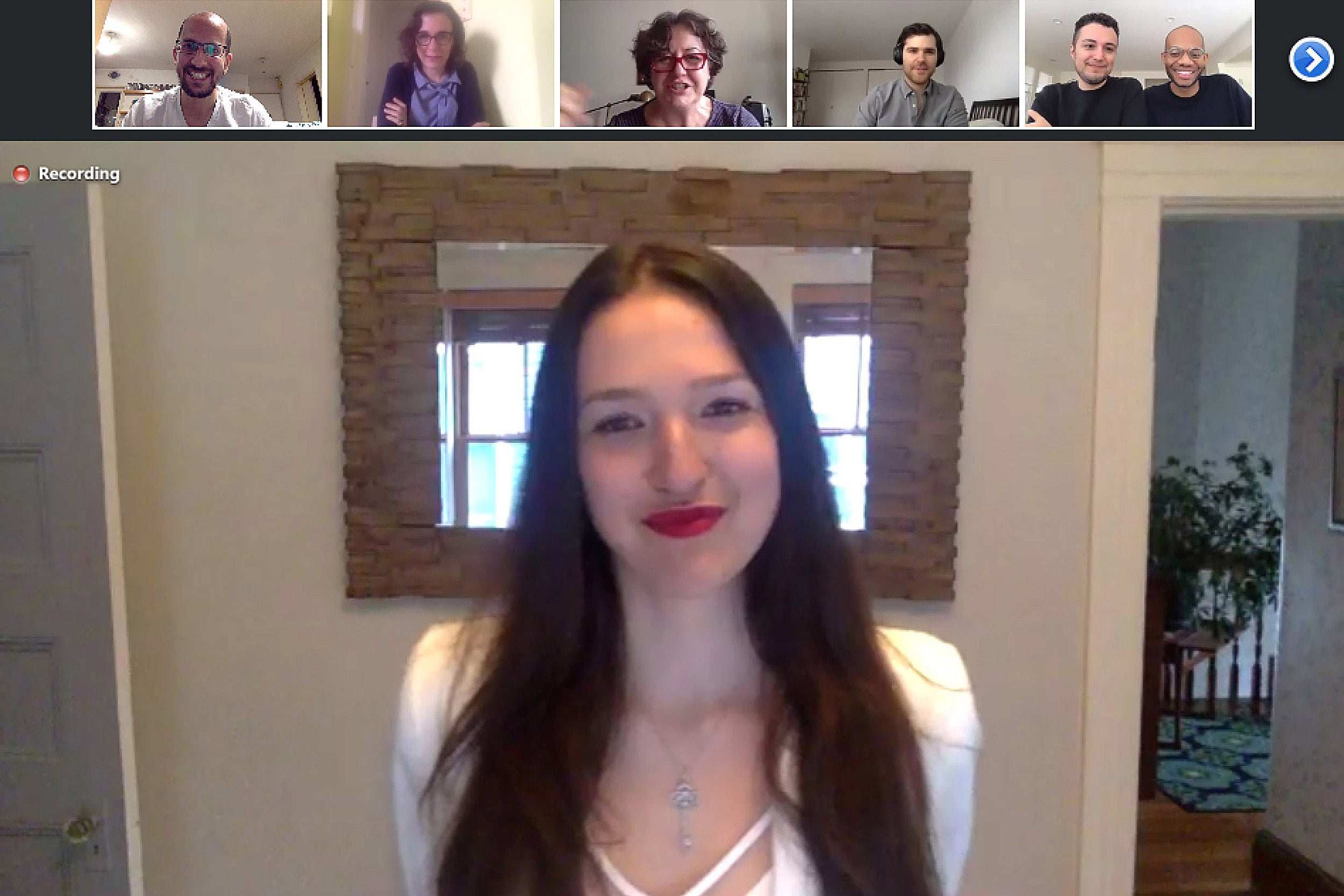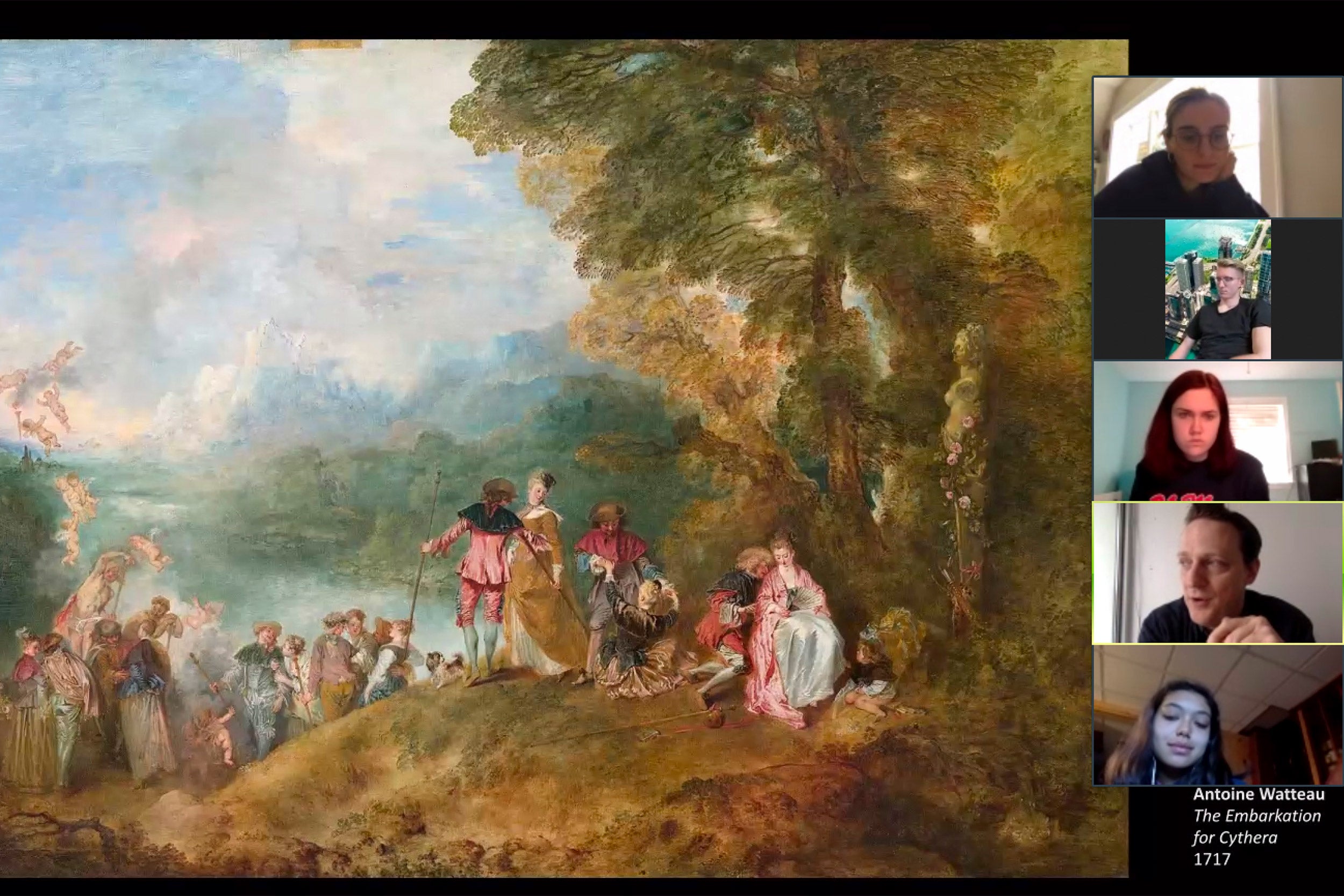
Jonathan Savilonis and sons Julius and Lysander have had extra time lately to work on their LEGO model of Harvard’s Music Building.
Courtesy of Jonathan Savilonis
Notes from the new normal
Bits of the socially distanced lives of staff and faculty, from a LEGO model of the Music Building to Gov. Andrew Cuomo as Henry V to cereal for dinner — in the shower
Socially distancing at home has been productive for building manager Jonathan Savilonis and his twin 5-year-old sons, Julius and Lysander. They had been working on a LEGO model of the Music Building, which includes the Loeb Music Library and John Knowles Paine Concert Hall, for nearly six months when Savilonis did a few sketches and started thinking about how to scale up the project. Now that the family has extra time inside, they’ve made good progress.
“We made a fairly expensive purchase of 3,000 red masonry bricks and some windows from a brick seller in Germany last month,” Savilonis said. “We started building on March 17 when the order arrived. Having all the ordered parts I need and a pretty large assortment of already sorted LEGO has made things go pretty quick.”
Savilonis works on the project daily.
“Honestly, my boys lost interest pretty quickly and returned to building a spaceship and robots in the LEGO [playroom] while I worked away about an hour an evening and a couple longer sit-downs here and there,” he said.
The LEGO Music Building is nearly complete and includes all three structures that comprise its modern iteration. Savilonis’ Paine Concert Hall — the original of which was built in 1914 and designed by the architect firm of alumni John Mead Howells (Class of 1891) — includes LEGO marble steps, columns, and window treatments that mirror the original’s (most impressive, the Steinway piano on the Paine Hall stage). His Eda Kuhn Loeb Music Library (1956) is landscaped with LEGO plantings, and the 1972 Mason addition features LEGO plate glass windows and a roof ladder.
“It has been really fun to figure out how to scale the project and watch it take shape. I have never built anything this large before,” said Savilonis. “The best part is sharing it.”
Getting a clue
For a socially distanced world, CS50x’s Puzzle Day may be the ideal team contest.
Since its inception in 2016, the annual event has been an online adaptation of the on-campus Puzzle Day that is part of “Introduction to Computer Science,” taught by David J. Malan, Gordon McKay Professor of the Practice of Computer Science.
The virtual competition gives everyone in the world the chance to form remote teams and tackle a series of logic problems (no computer science experience needed). The goal is to complete as many puzzles as possible before the end of the contest.
While online teams are the norm, with most Harvard students spending the spring term at home, this year’s competition could be a golden opportunity for entire families living under one roof to participate together.
Teams of two, three, or four are encouraged, but individuals can participate solo, as well. Nearly 9,000 people registered for last year’s CS50x Puzzle Day.
The game begins any time after midnight (in each player’s time zone) on Friday, and ends any time before 11:59 p.m. on Monday. Every team member must register at https://cs50.ly/register to participate.
If you are curious about what the competition entails, or want to practice, click here for last year’s puzzles and solutions.
‘Argument’ clinic
Edward J. Hall’s “Gen Ed 1051: Reclaiming Argument” has become must-see TV for Lorae Stojanovic ’22 and her mom. The chair of the philosophy department was asking for feedback that would inform future seminars when Stojanovic, a Cincinnati native, offered that her mom got as much out of the first online lesson as she did.
“The first lecture video was great! I played it on the TV of my living room, and my mom, who was occupied cleaning some purses she resells online, began to watch. It reminded her of one of her favorite courses from college; she said she really enjoyed watching.”
The happy few
Derek Miller, John L. Loeb Professor of the Humanities in the English Department, listened to Gov. Andrew Cuomo’s news conference on March 27 and was struck immediately by how closely his speech echoed the famous St. Crispin’s Day speech from Shakespeare’s “Henry V,” in which the young king rallies his troops before the Battle of Agincourt.
Just how Henry V was Cuomo today? Compare: pic.twitter.com/MWQNnredA4
— Derek Miller (@DerekKMiller) March 27, 2020
He tweeted the speeches alongside one another, later telling the Gazette: “I’ve been teaching the play this semester, so it was fresh on my mind. Cuomo echoed Shakespeare’s Henry primarily by calling attention to the historic nature of what was taking place. Just as Henry foretells that ‘He that outlives this day and comes safe home/Will stand a tiptoe when this day is named,’ Cuomo imagines the members of New York’s National Guard telling their grandchildren about their exploits, mingling grief for lives lost with pride in a job well done.
“And Cuomo, like Henry, emphasized shared sacrifice. Cuomo spoke about what ‘we’ are doing ‘together’ and promised to ‘fight this fight with you,’ recalling Henry’s address to his army as a ‘band of brothers.’ It hit so many of the same notes from Henry’s speech that I joked on Twitter that it was a ‘Shakespeare for Dummies’ translation. More seriously, though, I felt that Cuomo’s speech was just as powerful, in its modern idiom, as Henry’s, even outdoing Shakespeare in his impressive use of anaphora.
“This was a reminder that a leader’s oratory plays a central role in creating a sense of communal purpose at times of danger. By casting this challenge in historic terms, Cuomo helped give everyone’s daily fear and drudgery meaning, even for a brief moment. In Shakespeare’s play, the speech wins Henry the Battle of Agincourt against the vastly larger French army. Let’s hope Cuomo’s speech — and all the other labor it inspired — has a similarly good effect on our fight against this pandemic.”
No one will know
And finally, a tweet from Peter Girguis, professor in organismic and evolutionary biology and director of Harvard Microbial Sciences Initiative:
Today was a flaming hot tire fire of endless ZOOM meetings and countless kid fights.
— Pete R. Girguis (@pgirguis) March 25, 2020
I swear this is true: I had a bowl of cereal for dinner, which I ate while taking a hot shower. That’s my new “me time”, eating cereal in the shower.
Don’t judge me.
— Compiled by Jill Radsken, Lesley Bannatyne, Adam Zewe, and Sarah Zeiser









